In today’s fast-paced world, having a solid understanding of auto insurance coverage is essential for every driver. Whether you’re a seasoned driver or a new one hitting the road, knowing the ins and outs of auto insurance can save you from financial turmoil in case of accidents or mishaps.
1. Liability Coverage:
Liability coverage is the backbone of auto insurance policies. It protects you financially if you’re responsible for injuring someone or damaging their property in an accident. Most states require drivers to have a minimum amount of liability coverage, but it’s often advisable to opt for higher limits to safeguard your assets. Liability coverage typically consists of two parts: bodily injury liability and property damage liability.
2. Collision Coverage:
Collision coverage comes into play when your vehicle collides with another object, such as another vehicle or a stationary object like a tree or pole. It helps cover the cost of repairing or replacing your vehicle, regardless of who is at fault in the accident. Collision coverage is particularly valuable for newer or more expensive vehicles, as repair or replacement costs can be substantial.
3. Comprehensive Coverage:
Comprehensive coverage provides protection against damages to your vehicle that are not caused by a collision. This includes theft, vandalism, natural disasters, and collisions with animals. While comprehensive coverage is optional, it can offer valuable peace of mind and financial protection in a variety of situations.
4. Personal Injury Protection (PIP) or Medical Payments Coverage:
Personal Injury Protection (PIP) or Medical Payments Coverage is designed to cover medical expenses for you and your passengers in the event of an accident, regardless of who is at fault. PIP typically extends beyond medical bills to cover lost wages and other related expenses. This coverage is mandatory in some states and optional in others, but it can be incredibly beneficial in ensuring you and your passengers receive necessary medical care after an accident.
5. Uninsured/Underinsured Motorist Coverage:
Uninsured/Underinsured Motorist Coverage protects you in the event you’re involved in an accident with a driver who either has no insurance or insufficient coverage to pay for damages. This coverage can help cover medical expenses, lost wages, and vehicle repairs in such situations, ensuring you’re not left financially vulnerable due to someone else’s negligence.
6. Gap Insurance:
Gap insurance is particularly relevant for individuals who lease or finance their vehicles. In the event your vehicle is totaled in an accident, gap insurance covers the difference between the actual cash value of the vehicle and the amount still owed on the lease or loan. Without gap insurance, you could be left owing money on a vehicle you no longer possess.
Understanding these different types of auto insurance coverage is crucial for making informed decisions when purchasing a policy. By assessing your individual needs and risk factors, you can tailor your coverage to provide adequate protection for you, your passengers, and your vehicle. Additionally, regularly reviewing your policy and coverage limits can ensure you’re adequately protected as your circumstances change over time.

